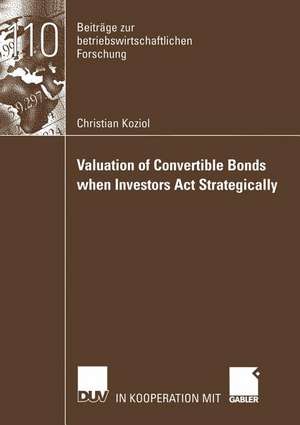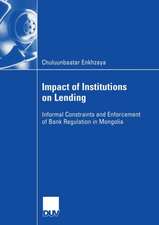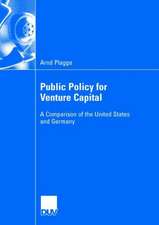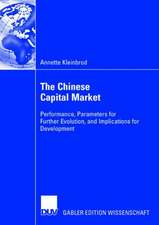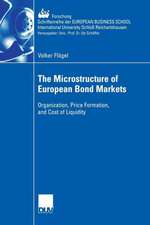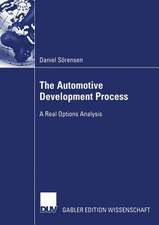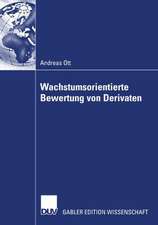Valuation of Convertible Bonds when Investors Act Strategically: Beiträge zur betriebswirtschaftlichen Forschung, cartea 110
Autor Christian Koziolen Limba Engleză Paperback – 30 mar 2004
Din seria Beiträge zur betriebswirtschaftlichen Forschung
-
 Preț: 412.68 lei
Preț: 412.68 lei -
 Preț: 419.21 lei
Preț: 419.21 lei -
 Preț: 498.73 lei
Preț: 498.73 lei - 15%
 Preț: 586.88 lei
Preț: 586.88 lei -
 Preț: 446.16 lei
Preț: 446.16 lei - 15%
 Preț: 585.40 lei
Preț: 585.40 lei -
 Preț: 453.01 lei
Preț: 453.01 lei -
 Preț: 419.06 lei
Preț: 419.06 lei - 15%
 Preț: 581.79 lei
Preț: 581.79 lei - 15%
 Preț: 443.81 lei
Preț: 443.81 lei - 15%
 Preț: 470.06 lei
Preț: 470.06 lei - 15%
 Preț: 442.48 lei
Preț: 442.48 lei - 15%
 Preț: 526.50 lei
Preț: 526.50 lei - 15%
 Preț: 696.82 lei
Preț: 696.82 lei -
 Preț: 418.83 lei
Preț: 418.83 lei -
 Preț: 450.88 lei
Preț: 450.88 lei -
 Preț: 480.83 lei
Preț: 480.83 lei - 15%
 Preț: 587.53 lei
Preț: 587.53 lei - 15%
 Preț: 443.31 lei
Preț: 443.31 lei -
 Preț: 413.07 lei
Preț: 413.07 lei -
 Preț: 381.81 lei
Preț: 381.81 lei - 15%
 Preț: 539.41 lei
Preț: 539.41 lei -
 Preț: 481.34 lei
Preț: 481.34 lei -
 Preț: 414.80 lei
Preț: 414.80 lei -
 Preț: 383.12 lei
Preț: 383.12 lei -
 Preț: 479.47 lei
Preț: 479.47 lei -
 Preț: 388.72 lei
Preț: 388.72 lei - 15%
 Preț: 447.89 lei
Preț: 447.89 lei -
 Preț: 417.52 lei
Preț: 417.52 lei -
 Preț: 416.71 lei
Preț: 416.71 lei -
 Preț: 412.51 lei
Preț: 412.51 lei -
 Preț: 414.21 lei
Preț: 414.21 lei - 15%
 Preț: 443.31 lei
Preț: 443.31 lei -
 Preț: 421.17 lei
Preț: 421.17 lei -
 Preț: 412.89 lei
Preț: 412.89 lei -
 Preț: 412.51 lei
Preț: 412.51 lei -
 Preț: 426.18 lei
Preț: 426.18 lei -
 Preț: 418.83 lei
Preț: 418.83 lei -
 Preț: 421.72 lei
Preț: 421.72 lei -
 Preț: 414.65 lei
Preț: 414.65 lei -
 Preț: 416.92 lei
Preț: 416.92 lei -
 Preț: 414.04 lei
Preț: 414.04 lei -
 Preț: 416.92 lei
Preț: 416.92 lei -
 Preț: 414.42 lei
Preț: 414.42 lei -
 Preț: 417.52 lei
Preț: 417.52 lei -
 Preț: 415.02 lei
Preț: 415.02 lei -
 Preț: 414.04 lei
Preț: 414.04 lei -
 Preț: 418.07 lei
Preț: 418.07 lei
Preț: 381.98 lei
Nou
Puncte Express: 573
Preț estimativ în valută:
73.09€ • 76.52$ • 60.48£
73.09€ • 76.52$ • 60.48£
Carte tipărită la comandă
Livrare economică 05-19 aprilie
Preluare comenzi: 021 569.72.76
Specificații
ISBN-13: 9783824491322
ISBN-10: 382449132X
Pagini: 224
Ilustrații: XVII, 200 p.
Dimensiuni: 148 x 210 x 17 mm
Greutate: 0.27 kg
Ediția:Softcover reprint of the original 1st ed. 2004
Editura: Deutscher Universitätsverlag
Colecția Deutscher Universitätsverlag
Seria Beiträge zur betriebswirtschaftlichen Forschung
Locul publicării:Wiesbaden, Germany
ISBN-10: 382449132X
Pagini: 224
Ilustrații: XVII, 200 p.
Dimensiuni: 148 x 210 x 17 mm
Greutate: 0.27 kg
Ediția:Softcover reprint of the original 1st ed. 2004
Editura: Deutscher Universitätsverlag
Colecția Deutscher Universitätsverlag
Seria Beiträge zur betriebswirtschaftlichen Forschung
Locul publicării:Wiesbaden, Germany
Public țintă
ResearchCuprins
1 Introduction.- 2 Convertible Bonds: Markets, Motives, and Traditional Valuation.- 2.1 The German Convertible Bond Market.- 2.2 Motives for the Use of Convertible Bonds.- 2.3 Valuation of Convertible Bonds.- 2.4 Analysis of Observed Conversion Volume.- 3 General Framework for the Analysis of Convertible Bonds.- 3.1 Model Framework.- 3.2 Asset Pricing in the Presence of Interest Rate and Firm Value Uncertainty.- 3.3 Basic Relations between Asset Values.- 4 Optimal Conversion Strategies and Valuation of Convertible Bonds at Maturity.- 4.1 Block Conversion.- 4.2 Unrestricted Conversion.- 4.3 Monopolistic Conversion.- 4.4 Analysis without additional Debt.- 5 Optimal Conversion Strategies and Valuation of Convertible Bonds before Maturity.- 5.1 Block Conversion.- 5.2 Unrestricted Conversion.- 5.3 Monopolistic Conversion.- 5.4 Analysis without additional Debt.- 6 Comparison of the Results for the three Conversion Variants.- 6.1 Analysis at Maturity of the Convertible Bond.- 6.2 Analysis before Maturity of the Convertible Bond.- 6.3 Analysis without additional Debt.- 7 Optimal Conversion Strategies and Valuation of Convertible Bonds in a Multi Period Framework.- 7.1 Optimal Conversion Strategies and Valuation of Convertible Bonds at an Arbitrary Point in Time.- 7.2 Comparison of the Results for the three Conversion Variants at an arbitrary Point in Time.- 7.3 Relations between the Conversion Strategies and between the Asset Values over Time.- 8 Conclusion.
Notă biografică
Dr. Christian Koziol ist wissenschaftlicher Assistent bei Prof. Dr. Dr. h.c. Wolfgang Bühler am Lehrstuhl für Finanzierung der Universität Mannheim.
Textul de pe ultima copertă
Convertible bonds are interest bearing securities that can be converted into stocks. Therefore, the investors' strategy is a fundamental pricing factor. It is particularly important whether a firm has debt outstanding in addition to convertible bonds and stocks, because the conversion decision results in a wealth transfer between debt and stock holders.
Christian Koziol analyzes conversion strategies and the related values of stocks and convertible bonds when firms have additional debt outstanding. For this purpose, he applies a multi period framework in the presence of both firm value and interest rate uncertainty. He shows that various conversion strategies can be optimal, which result in different values for stocks and convertible bonds, depending on the underlying conversion variant, i.e. monopolistic conversion, perfect competition, or block conversion. A comparative static analysis examines the differences between the properties of the optimal conversion strategies and between the asset values for the three conversion variants. One of the - partly surprising - results is that the convertible bond value is highest under monopolist conversion and that the value under block conversion is lower than under perfect competition.
Christian Koziol analyzes conversion strategies and the related values of stocks and convertible bonds when firms have additional debt outstanding. For this purpose, he applies a multi period framework in the presence of both firm value and interest rate uncertainty. He shows that various conversion strategies can be optimal, which result in different values for stocks and convertible bonds, depending on the underlying conversion variant, i.e. monopolistic conversion, perfect competition, or block conversion. A comparative static analysis examines the differences between the properties of the optimal conversion strategies and between the asset values for the three conversion variants. One of the - partly surprising - results is that the convertible bond value is highest under monopolist conversion and that the value under block conversion is lower than under perfect competition.
